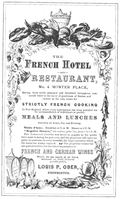Locke-Ober
|
Locke-Ober Restaurant | |
|
| |
|
Locke-Ober Restaurant as it appeared in 2009 | |
| Location | Boston, Massachusetts |
|---|---|
| Coordinates | 42°21′19.74″N 71°3′41.41″W / 42.3554833°N 71.0615028°WCoordinates: 42°21′19.74″N 71°3′41.41″W / 42.3554833°N 71.0615028°W |
| Built | 1832 |
| Architect | Unknown |
| Architectural style | Greek Revival |
| Governing body | Private |
| NRHP Reference # | 86001911 [1] |
| Added to NRHP | July 24, 1986 |
Locke-Ober (ca.1875-2012), located at 3-4 Winter Place, was the third-oldest restaurant in Boston, Massachusetts, after the Union Oyster House (1826) and Durgin-Park (1827). Locke-Ober featured French cuisine and seafood.
History
The Greek Revival building was constructed in 1832. By 1862, the Boston City Directory listed Adrien Destre as operating a restaurant at 4 Winter Place.[2] By 1868, F.A. Blanc was listed as running the restaurant. By 1879, Boston city records listed Luis Ober as the proprietor of a restaurant at 4 Winter Place of "over twenty years' standing." From the start, the restaurant specialized in French food and had been central to the financial, political, and intellectual history of Boston.[3]

Louis Ober was born in 1837 in the French department of Alsace. At age of fourteen Ober moved to New York, working as a barber, book seller and importing and exporting goods between the United States and France. Ober lived and worked in New Jersey, Cincinnati, and Philadelphia, before settling in Boston. Ober was employed at the restaurant then owned and operated by Blanc. While in Blanc's employ, Ober became familiar with French food, fine wine and furnishings. By 1875, Ober had acquired ownership and applied to the city for expansion of the restaurant to 3-4 Winter Place. Financing was provided by Eben Jordan, a co-founder of the Jordan Marsh Company. The restaurant reopened as Ober's Restaurant Parisien.
Over the next 20 years the restaurant was expanded and became furnished with increasingly luxurious imported materials typical of the Gilded Age, including Honduran mahogany, French furniture, Italian and French sculpture and paintings, English silver and Bohemian crystal lighting.
By the late twentieth century, Locke-Ober - though still possessing most of its original grand trappings - had lost much of its popularity.,[3][4] Boston restaurateur Lydia Shire, with investor Paul Licari, leased the space in 2001 and began a painstaking restoration of the main and private dining rooms on the third floor, adding two more contemporary rooms. Jacky Robert was executive chef until 2003. Nonetheless, the restaurant closed in 2012, with reports that the owners planned to sell the building.[5]
The building was added to the National Register of Historic Places in 1986.[1]
See also
References
- ↑ 1.0 1.1 "National Register Information System". National Register of Historic Places. National Park Service. 2008-04-15.
- ↑ The Boston directory (1862) v. 58 (Sampson, Davenport, 1862)
- ↑ 3.0 3.1 Locke Ober Leaves Legacy
- ↑ Locke-Ober owner David Ray explains his decision to close
- ↑ Jeremy C. Fox, Derek J. Anderson (October 21, 2012). "Locke-Ober restaurant is closed for business". Boston Globe. Retrieved 21 October 2012.
- Forbes, Esther, and Arthur Griffin. The Boston Book. Houghton Mifflin Company: 1947.
- Morrisey, Louise Lane, and Marion Lane Sweeney. An Odd Volume of Cookery. Houghton Mifflin Company: 1949.
External links
- Official Website of Locke-Ober (dead link)
| |||||||||||||||||||||||||||||||||||||||||||||||||||||||
